Too often in the past 20 years pond fish culture has been freely advocated as a form of development of food resources. No especial consideration was given to whether this was really the best development in relation to the environmental conditions and economic state of the area.
Before planning any fish culture project, it is necessary first to decide whether it is really the best method of fish production for the area, or whether another form of fisheries development should be considered. In areas where large natural fisheries exist, for example, there is little point in developing any form of fish culture. First, there must be full exploitation of the natural fishery, bringing benefit to as many people as possible in the region.
Generally speaking, the areas in which fish pond culture is likely to be a sound form of development are those which satisfy some of the following conditions:
There is a shortage of animal protein for consumption.
There are no large natural fisheries.
There are adequate surface water supplies.
There is a ready market for the cash sale of fish.
There already exists a combination of fish ponds with forms of agriculture such as vegetable growing, poultry, pig farming, etc., or a potential for this combination.
Once the form of fish culture development for an area has been decided upon, the development may be put into effect.
It has been found by experience that no matter what type of fish culture is contemplated, the development is most easily and surely brought about through the following stages: (a) demonstration; (b) instruction; (c) extension.
Demonstration involves the setting up of a demonstration unit consisting of a small unit of fish ponds or conservation dams.
A fish pond unit must be of economic size, sited in a place and constructed in a manner typical of what is possible for the area as a whole. It must also be combined with other forms of agriculture applicable to the region.
A conservation dam unit may consist of either one or two dams, characteristic of the area, where both good and bad management practices can be demonstrated.
It cannot be overstressed that the demonstration should be typical of what can be done in the area, because individual efforts will exactly reflect the demonstration. It is therefore of little use to demonstrate a unit of barrage-type fish ponds when the terrain of the development area is better suited to contour ponds. Similarly, a demonstration of large perennial dam management is futile in an area where most dams are likely to be small and nonperennial.
Instruction involves the use of the demonstration unit for field days and courses of instruction to show the people of the region how the unit is managed and what results can be obtained. Usually a short time after the demonstration and instruction stages, inquiries are received from potential fish farmers and dam owners. This leads to the third and most important stage of development, extension.
Extension involves the use of trained staff to advise and assist farmers on the spot. This staff chooses sites, lays out fish ponds, advises and checks on construction, arranges for pond stocking and pays frequent visits to advise and assist in pond management. In conservation dam fishery development, staff are required to work with dam owners, whether private or local authorities, and advise on stumping, stocking and cropping. It is even desirable that they should run dam cropping schemes for the first year.
Extension work is very important and the provision of adequate staff is most essential.
Ponds can be described according to where and how they are made and the use to which they are put.
The main kinds of ponds are contour ponds, barrage ponds and paddy ponds.
Contour ponds are made on sloping ground. The bottom walls of the pond lie along the contour of the ground. Contour ponds are constructed along the sides of valleys and sometimes dambos (vleis), the water coming in a furrow from a stream or sometimes a conservation dam. A unit of contour ponds is illustrated in Figure 1.

Figure 1. Contour ponds.
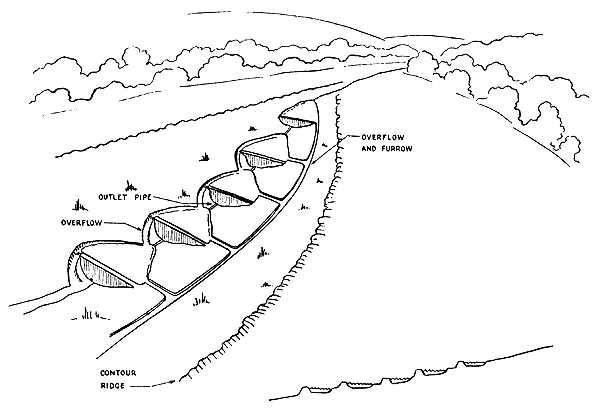
Figure 2. Barrage ponds made in a small dambo. Walls about 4 ft high are built across the dambo one below the other. Each pond has an outlet pipe and an overflow. At the first pond the overflow is continued as a furrow so that water can be put into the lower ponds when it is needed. Contour ridges are made on either side of the dambo and thus the ponds are not flooded in the rains.
Barrage ponds are made by building a wall across a small dambo or stream and the ponds are therefore like small conservation dams. Water for these ponds comes from a spring, or a “mushitu” or seepage area. It is very important that ponds of this type should not be constructed in places where there will be a very large flood of water down the stream or dambo in the rainy season.
Sometimes barrage ponds are made below large conservation dams making use of seepage water. In such cases the water in the first pond of a series must be at least 50 feet from the bottom of the dam wall. Units of barrage ponds are illustrated in Figures 2 and 3.
Paddy ponds are made in places where the ground is flat, or almost flat, such as in dambos or swamps and flood plains. The water for the ponds comes in a furrow from a stream, or from seepage in the area, or sometimes from springs. Because paddy ponds are made on flat ground, four walls must usually be made to each pond, as compared with three for contour ponds and only one for barrage ponds. The water supply often has to be brought to the ponds on top of a specially constructed dike and is distributed by furrows on top of the pond walls. The walls of paddy ponds are of a wider construction than the walls of other kinds of ponds because the soil is usually not so firm. A unit of paddy ponds is illustrated in Figure 4.
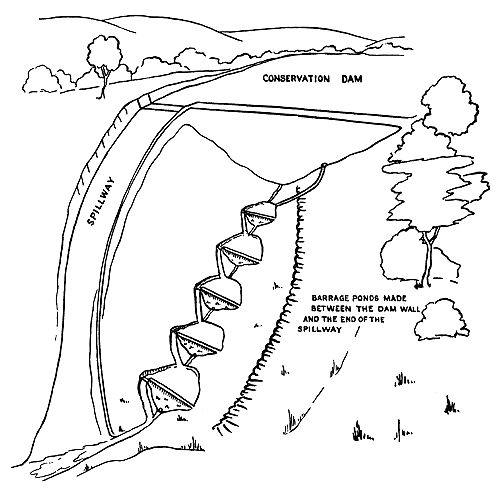
Figure 3. Barrage ponds made below a conservation dam.
In some parts of the world where the culture of fish in ponds tends to be rather specialized, ponds are used for special purposes. In Europe, for example, carp culture requires special ponds for breeding, special ponds for rearing and special ponds for growing table fish.

Figure 4. Paddy ponds made in a flat dambo. There should be provision for drainage.
In central east Africa where pond fish culture is very largely of the Cichlids, such as Tilapia and Haplochromis, normally no ponds of special construction are needed for any particular stage of their culture.
Fish breed and grow in the same pond and, in fact, one of the greatest problems of Cichlid culture is their prolific breeding in ponds.
With the development of Tilapia “hybrids,” it will be necessary to have separate ponds set aside for crossbreeding and separate ponds for growing the progeny to edible size. These ponds will not, however, differ materially in construction, but merely in size and in the degree of control devices.
The place where fish ponds are made is called the pond site. When choosing a site for fish ponds these factors must be considered:
Water supply;
Soil, rocks and trees;
Supporting services.
Of course, fish ponds can be made almost anywhere, but some sites are better than others and may be developed more economically. Fish ponds could be constructed on the top of Kilimanjaro, but it would hardly be an economic proposition.
Water and water supply
Amount of water
One of the most important requirements for the successful development of fish ponds is an adequate water supply. Water is required not only to fill up ponds in the first place, but to replace water lost by evaporation and by seepage. The loss of water by evaporation is greatest in hot dry weather.
The amount of water lost by seepage will depend on the kind of soil in the place where the ponds are sited and on how well the ponds are made. If walls are not properly constructed, seepage may sometimes be so great that ponds will not hold water for more than a few hours after being filled up.
Suitable soils for making fish ponds are referred to on page 21.
New ponds often lose more water from seepage than old ponds. Fish in ponds stir up mud at the bottom and make a fine silt that helps to stop the leaks.
In central east Africa it has been found that the water supply to a unit of contour ponds could vary between 4,000 and 25,000 gallons per acre per day. On average, contour ponds require between 10,000 and 15,000 gallons of water per acre per day in areas where the rainfall is 30 to 35 inches a year and mean monthly temperatures are within the range of 15° to 26°C (59° to 78°F), where there is little pond seepage.
Barrage ponds require less water than contour ponds, because the seepage from one pond is used by the next in the series. Usually with barrage ponds it is necessary only to run water into the first of the series to keep it full.
If ponds are combined with the irrigation of vegetables and other crops, then extra water will be needed. For example, for a small holding of half an acre of ponds and half an acre of vegetables and fruit trees, recorded water requirements have been 30,000 to 50,000 gallons of water a day depending on the time of year. In this instance, however, seepage from the pond unit was excessive and irrigation was not efficient.
The water supply for fish ponds is very important. If there is not enough water all the year round, it is no good making ponds, as they will dry up and the fish will die. It is better to overestimate rather than underestimate water requirements.
Careful planning and situation of ponds can result in a reduction of the amount of water needed, e.g., for contour ponds made in terraces, the lower series seldom require a direct water supply, as they are kept full from seepage from the upper terraces' water table.
Water sources
It has already been stated that the water supply for a fish pond is very important and that there must be enough water all the year round. The most important sources of water for fish ponds are:
Perennial streams and rivers.
Springs and “mushitu.” (A mushitu is a relict of tropical forests found in certain areas of central east Africa and always has water seeping from it.)
Very large conservation dams. Small dams are not a reliable source of water.
The important feature of the water source is that it must be reliable and adequate. Many rivers and streams in central east Africa have adequate water in the rainy season but stop flowing in the dry season. Such rivers and streams are not recommended as a direct source of water for fish ponds. Where river and stream water supplies are unreliable, conservation dams should be built and used for fish production.
Quality of water
It is not within the scope of this section to deal in detail with the quality of water. Just as some soils are better than others for growing crops, so some waters are better than others for growing food on which fish feed.
Water may be improved by adding fertilizers in the same way that soils can be improved.
In many parts of central east Africa where plenty of water occurs in rivers and streams the quality of the water is poor. This is not a serious matter because the water can be improved.
It is far more important that there should be enough water for fish ponds than that the water should be of good quality.
Arranging the water supply
Various ways of arranging the water supply to fish ponds are shown in Figure 5.
When a furrow is used to supply water, care must be taken to ensure that it is large enough to carry all the water required and that there is not too much seepage. Information on furrow sizes is given on page 151. Since fish pond development is usually part of other agricultural, irrigation development, there is seldom need for fisheries staff to be concerned over furrow siting.
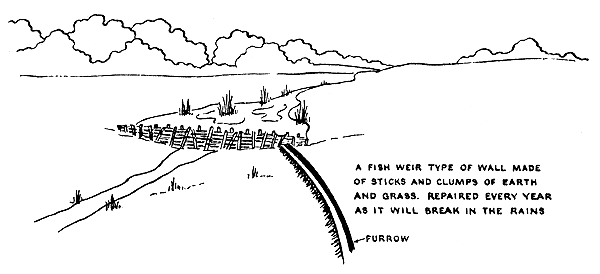
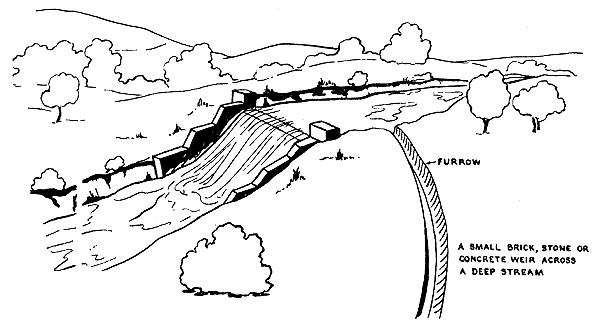
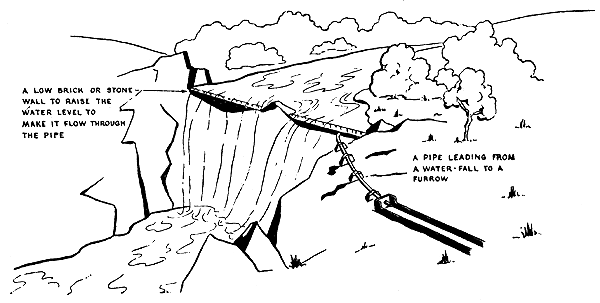
Figure 5. Arrangements for water supplies to fish ponds.
Soils, rocks and trees
Soils
Soils are considered here in regard to their water retention properties rather than from the point of view of fertility.
There are a number of different kinds of soil which are suitable for making fish ponds. Wet, swampy ground such as that found in dambos is usually very appropriate for this purpose. In fact, swampy ground is most usually used for fish pond sites. Sandy clay, some schists and laterites are also suitable.
Some heavy clays are very good for pond building, others not so good. The reason for this is that heavy clays when dry are very hard and crack, and some are difficult to seal up. If however the cracks are sealed up, then the ponds are usually very good and hold water well.
Well-drained soils and red soils have not proved to be particularly adapted for making ponds as seepage is often very great indeed.
Places in which there are anthills must be avoided as excessive seepage will occur through them.
Rocks and trees
Fish ponds must never be made where there are rock outcroppings because they will leak too much and cannot be sealed up properly. Sites having too many trees should also be avoided for it is costly to remove the trees properly. If there are a few trees they must be taken out and all the stumps and roots removed completely. The hole caused by the removal of the tree stump and roots must be filled with soil which must be stamped down hard. If trees and stumps are not taken out completely the pond may leak very badly, and also cannot be netted.
Size and position of site
The size of the site for fish ponds depends on the purpose of the ponds. If the aim is to be subsistence fishing only, then smaller sites may be used. Generally a subsistence pond should not be smaller than 1/10th of an acre, e.g., 20 × 25 yards.
If, however, the purpose is to be commercial production, a larger site is needed. A minimum of an acre of ponds is the smallest unit which should be considered for a commercial farm. A convenient unit is to have a minimum of 12 ponds so that one pond can be drained and the fish harvested each month of the year, thus assuring a regular supply of fish for sale and home consumption. For larger establishments, ponds in multiples of 12 are suggested for the same reason.
Although there is no objection to starting commercial pond fish culture in a small way with one or two ponds, the eventual aim should be a unit of ponds sufficient to produce economic results and the site selected should therefore have sufficient area of suitable ground for making the ponds.
The pond site should if possible be within sight of the house of the owner. If it is far from the owner's house, there is always danger of fish being stolen or eaten by animals such as otters. Also, when the pond is near the house of the owner, there is less chance that he will forget to look after the pond and the fish in it. The fishpond site should preferably be near the farmer's other agricultural activities, such as the vegetable garden, poultry, pigs, etc.
A fish pond is not just a hole in the ground, but a properly constructed place for breeding and growing fish. It has walls above the natural ground level, special places where water can be let in and taken out, and a place where, if necessary, water can overflow without breaking the walls. The different parts of a pond are shown in Figure 6.
Walls
The walls retain the water and form the pond. Their size depends on the depth of the pond. A deep pond must have larger walls than a shallow pond.
It is very important that the walls be sloped. The slope on the inside of the walls should be about 2 or 2½ to 1. The slope on the outside of the walls can be about 1:1. The slope depends on the kind of soil used to make the walls. Firm soils such as laterite or clay can have steeper slopes than the soft soils usually found in dambos.
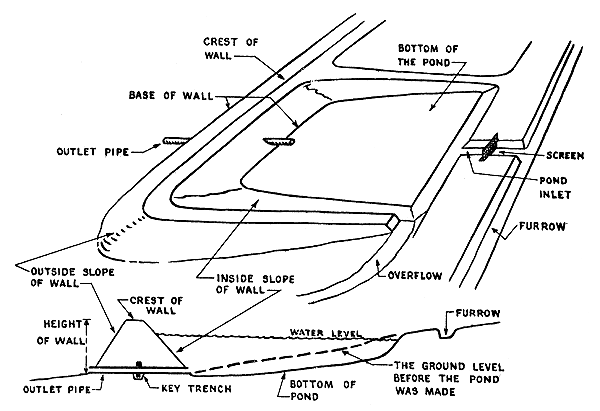
Figure 6. The parts of a fish pond.
The crest of the wall should not be less than 3 feet wide, and if ponds are made in swampy areas such as in dambos, the crest should be at least 4 to 5 feet wide.
If pond walls do not have the correct slopes on the inside and the crests are not wide enough, the walls may break and much repair work may have to be done. Measurements of walls of different crest widths are given in Figure 7.
The base widths of a pond wall vary with the height and can be roughly worked out as follows:
| For firm soils | Base width = 4 × height |
| Crest width 2 – 3 feet | |
| For soft soils | Base width = 5 × height |
| Crest width 4 – 5 feet |
Pond inlet
The pond inlet is the place where water can be let into a pond. It can be made in various ways and some of those more common and easily made are shown in Figure 8. To prevent erosion of the side of the pond when filling it with water, there should be an overhang at the inlet, or grass laid as a mat, or stones.
It is important that the inlet should be at least 6 in. above the water level of the pond, when the latter is full, and there should also be some sort of a screen. The screen serves to present fish escaping from the pond into the furrow, as well as to prevent “wild” fish coming down the furrow into the pond.
Arrangements must also be made for stopping the flow of water into the pond, since it is undesirable in Cichlid culture to have a continual flow of water into and out of the pond.
Pond outlet
The place where the water can be let out of the pond is called the pond outlet. This is usually a pipe underneath the bottom wall. In the case of small ponds a pipe of 2-in. diameter is suitable, but for larger ponds a larger pipe is needed (Figure 9).
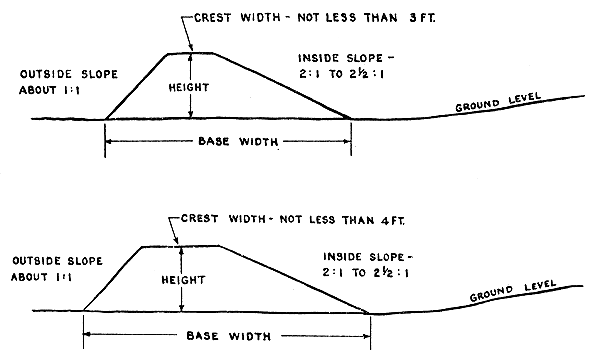
Figure 7. The measurements of pond walls. Above: Size of the wall for a contour pond made in firm soil such as laterite or clay. Below: Size of wall for paddy pond made in dambo types of soil.
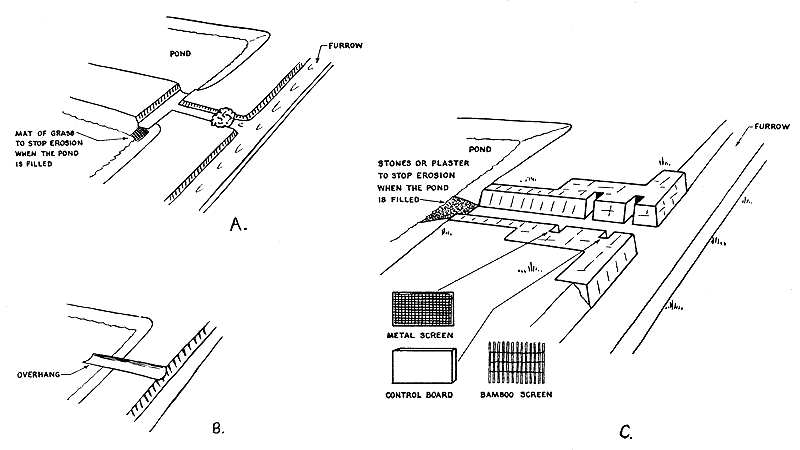
Figure 8. Pond inlets. A. A simple furrow type of inlet. It is blocked with earth when not in use. The sides of this type of furrow must be sloped. B. An inlet made of a section of pipe or a piece of bark. C. A furrow type of inlet made of brick or concrete, with slots for a control board and a screen. The control board is about ¾ in. thick. The screen can be cut from gravel screening of ¼-in. mesh or of bamboo.
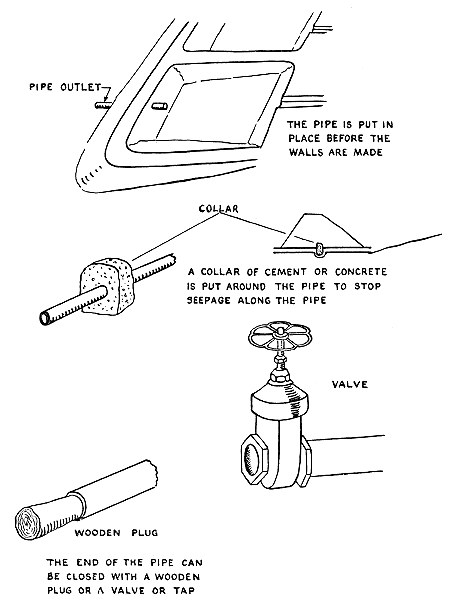
Figure 9. Pond pipe outlets.
Special kinds of outlets are the sluice and the monk. They are usually made of brick or concrete and are expensive (Figures 10 and 11).
If a pond does not have a pipe outlet, it can sometimes be emptied by siphoning or even by cutting through the wall (Figure 12).
POND OVERFLOW
The pond overflow is the place where water can flow out of the pond in emergencies — such as when there is very heavy rain — without breaking the walls. If a pond is looked after properly, it should not be necessary to use the overflow very often, because it is not a good thing to have water running through the pond all the time.
There are several different kinds of overflow which can sometimes be combined with the outlet, e.g., as in a monk or sluice.
Should the occasion arise, a screen, such as is used for inlets, can be put across the overflow to prevent fish going out of the pond. Various kinds of overflows are illustrated in Figures 13, 14 and 15.
The shape of contour and paddy-type ponds should be rectangular or square, preferably the former. Barrage ponds should have as regular a shape as possible.
Ponds irregular in shape are difficult to crop.
The size of a fish pond is the area of the water surface and is usually given in acres. The area of rectangular ponds can be worked out from the length and width in yards. (In Appendix 4 the lengths and widths of different sizes of ponds are given.)
A unit of ponds should be planned so that all the ponds are of about the same size.
The larger the pond, the lower is the cost of construction relative to the area. For example, the total cost of making 10 ponds, each 1/10th acre in area, could be twice as much as the total cost of making two ponds of ½ acre each, even if made under similar conditions. However, not everyone has sufficient money to build large ponds and in rural areas units of ponds of about 1/10th of an acre each in surface area have been the most successful. Not only can the owner afford to build one or two ponds at a time, but these smaller ponds tend to be better managed and to produce relatively more fish than larger ones.
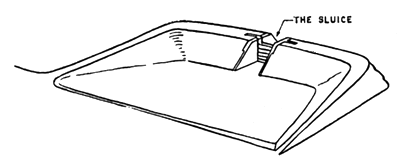


Figure 10. The sluice.

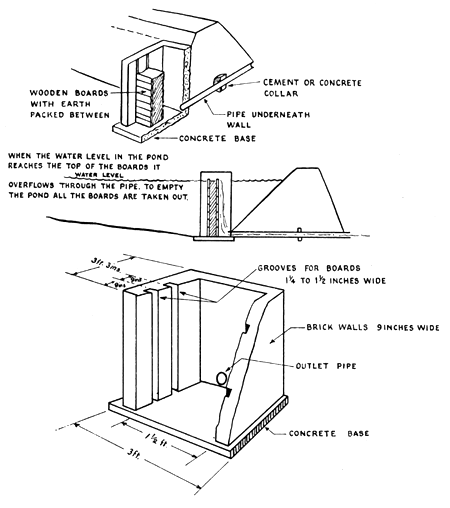
Figure 11. The monk.
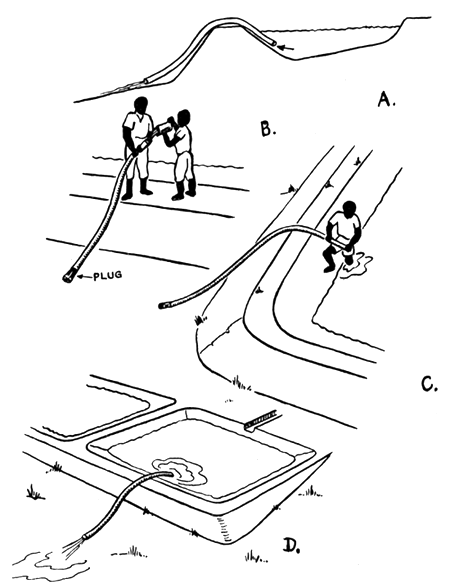
Figure 12. The siphon, a plastic or rubber hose pipe about 1½ in. diam. A. The pipe is put over the wall of the pond. The end of the pipe outside the pond must be lower than the end in the water. B. To start the siphon: Put an airtight plug in the end of the pipe outside the pond, and fill the pipe with water. C. When the pipe is full and overflowing put hand tightly over the end and put it quickly under water in the pond; then remove hand. D. Take the plug out of the pipe and the siphon should start.
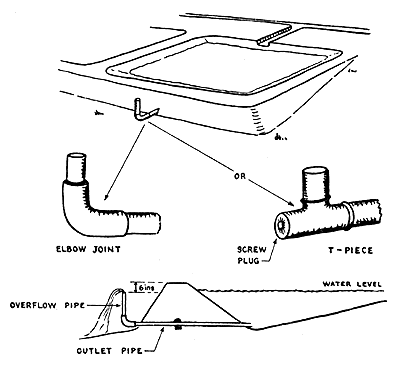
Figure 13. Pipe overflow. A pipe outlet can be fitted with an elbow or T-piece into which another piece of pipe is fitted. This pipe is upright outside the pond and is about 6 in. or more below the top of the wall. Water will come out of the top of the pipe if the pond becomes too full. It is only suitable for small ponds.
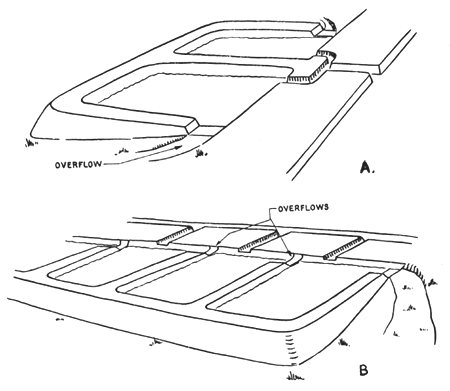
Figure 15. Spillway overflow. Overflows made like spillways can be used on large and small contour barrage ponds. The overflow spillway is made near the top of the pond and must be planted with grass. The danger of this kind of overflow is that fish can get into and out of the pond if water is kept running out all the time. Contour ponds can be made in pairs, each with a spillway type of overflow (A), or in series with overflows leading from one to the other (B).
Fish ponds must never be less than 1/20th of an acre in area. This is the smallest size worth managing.
Small fish ponds can be made with about the same depth of water all over, but it is better if the pond is deeper in one part near the outlet.
If ponds are made with the same depth all over, the depth of water can be about 3 ft.
If ponds are made with one part deeper than another, the water in the shallow part must not be less than 1½ ft, and in the deepest part it can be 3 to 3½ ft.
If ponds are made in places where the water supply is not reliable, the depth of water in the ponds should be increased to about 5 ft at the deep end. The same is suggested in areas where frosts or severe winters occur. If the water supply fails there is enough water in the pond to last another one or two months, the level dropping gradually.
When to make fish ponds
If fish ponds are made at the most suitable time, the work will be easier and the cost less than if they are made at another time.
The best time of the year for making ponds in soils such as clay and laterite is at the end of the rainy season when the soil is soft, rather than at the end of the dry season when it is very hard. The best time of year for making ponds in swampy ground, such as dambos, is in the dry season when the ground is not flooded with water.
How to make fish ponds
It is not possible in this manual to describe in detail all the ways in which fish ponds can be constructed. There are, however, certain steps to be taken and certain points to be watched to ensure that a pond is properly made.
Marking out the walls
The place for the bottom wall is marked out first, with height being shown with posts and width of the wall at the bottom with short pegs. For contour ponds the position of the bottom walls of the pond will depend on the slope of the ground. If the ground is steep then the bottom wall will be closer to the furrow than if the wall is not so steep.
For example, if the bottom wall of a contour pond is 15 yd from the furrow and the pond is 1/10th of an acre in area, then the side walls will be 30 to 35 yd apart. A “farmer's” type level, or a line level can be used for marking out pond walls. For barrage ponds the position of the wall will depend on the slope of the stream bed. For paddy ponds made on flat, or nearly flat, ground the bottom wall can be made in any position (Figures 16, 17 and 18).
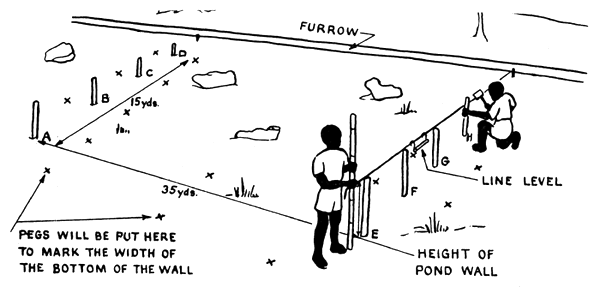
Figure 16. Marking the height of the walls for a contour pond. The distance from A to D is measured. If this distance is 15 yd (about 15 paces), another line of posts is put in 35 yd (about 35 paces) away, along the slope. These are posts E to H. The distance of the line of posts E to H away from the posts A to D depends on the distance A to D to make a pond of about 1/10th acre. Posts A-E-H-D mark the corners of the pond and show the height of the wall to be made.
It is important to mark out the bottom and side walls in the right places, because if they are in the wrong places it is more difficult to make the ponds and they will cost more.
Once the pond walls have been marked out, grass and any small bushes must be cleared away. If this is not done, the pond will leak when it is filled with water.
Key or core trench
The key or core trench is a small ditch or furrow dug along the line of the center of the walls, about 1 ft wide and 1 ft deep. As the walls are built, the trench is filled in again with a good clay soil and is well packed. If good clay soil is lacking in the area, the ordinary soil should be well compacted into the trench. The purpose of the trench is to stop the seepage of water underneath the walls. If there are any small anthills along the line of the walls, then the trench must be dug much deeper in order to prevent seepage (Figure 19).
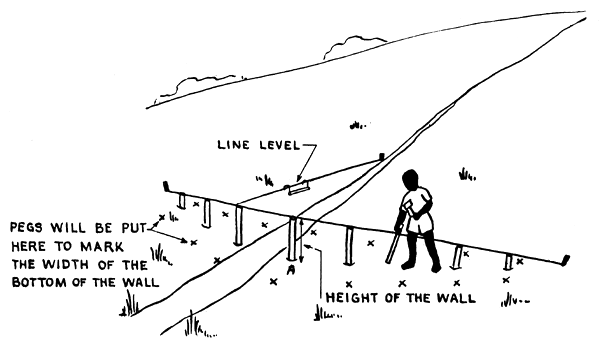
Figure 17. Marking the height of the wall for a barrage pond. Posts are put in a straight line across the dambo. The tops of the posts must be level with the top of the center post, A. These posts mark the center line of the bottom wall and the height to be made.
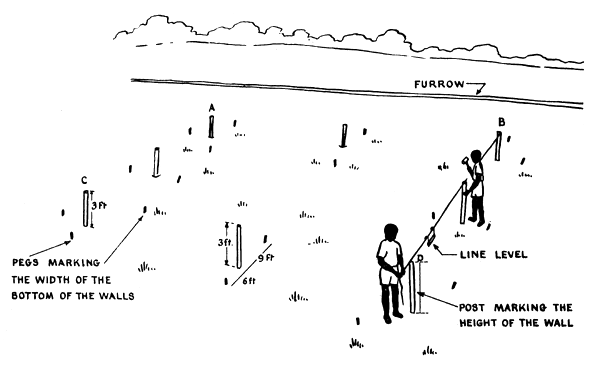
Figure 18. Marking out the walls of a paddy pond.
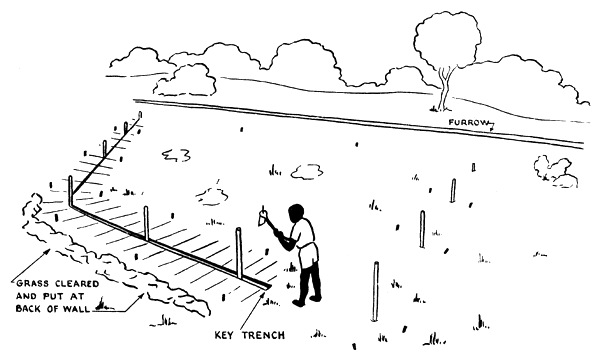
Figure 19. Making the key trench.

Figure 20. Putting in the outlet pipe.
Outlet pipe
Before the walls are made, the outlet pipe is put in. A collar of cement or concrete is put around the pipe at about the middle of the wall to stop water seeping along the pipe (Figure 20).
Making the walls
Soil for making the pond walls is taken from inside the pond. For contour ponds it is best to start digging the part of the pond nearest the intake furrow, i.e., furthest from the bottom wall. More soil is taken from the top of the contour pond than from near the bottom wall. For paddy ponds it is best to start in the middle of the pond and work toward the walls.
Where a good layer of fertile topsoil exists it is a good practice to remove this top layer to a pile near the pond site. Then the less fertile soil is used for the walls and on pond completion a layer of fertile soil is replaced on the bottom of the pond to promote pond fertility.
The bottom wall is the most substantial and needs more soil than the side walls (Figures 21, 22 and 23).
When the walls are the right height, stop digging. It is not necessary to have walls 10 or 12 ft high if the water is to be only 3 or 4 ft deep. When finished, the crests of all the walls should be level.

Figure 21. Making the walls of a contour pond. Soil to make the walls is dug first from the top of the pond. It is dug to a depth of 1 ft. Nearer the bottom wall, soil is dug less and less deep. As the walls are built up, the width is made less and less so that when the top of the posts is reached, the width is only 2 or 3 ft. Then the walls are high enough and digging stops. The bottom of the pond is made smooth.

Figure 22. Making the wall of a barrage pond. Earth is dug from inside the pond to make the wall. The wall is made narrower as it is built up. Earth is tamped down with a tree trunk or pole. When the top of the posts is reached, the wall is finished.

Figure 23. Making the walls of a paddy pond. Soil to make the walls is dug first from the center of the pond. It is dug to a depth of about 9 in. in the center but at the top of the pond it is dug to only about 6 in. At the bottom end of the pond the soil is dug to a depth of about 12 in.
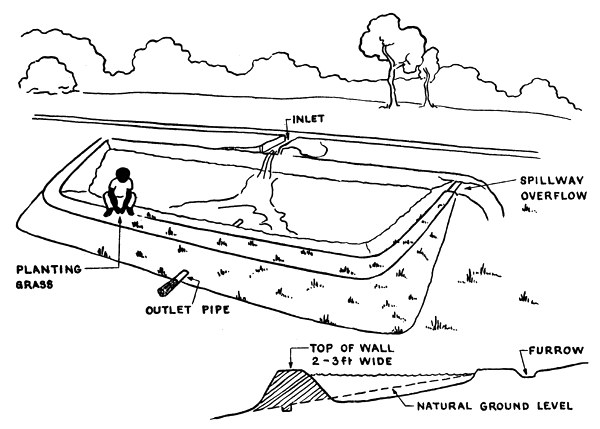
Figure 24. Finishing the pond. An overflow is made at the side of the pond. An inlet from the furrow is made. A wooden tap or plug is put in the outlet pipe and the pond filled with water. Grass is planted on the walls.
The walls should be sloped below the natural ground level first, then the slope can be continued to the top of the wall. If the soil is very dry it must be watered. If the pond is made by hand, the soil must be beaten down with a pole or small tree trunk.
Inlet and overflow
When the pond walls are completed the inlet and overflow are put in and the pond can be filled with water (Figure 24).
Grass planting
After the pond is finished grass should be planted on the walls as a protection. It can also be cut for fish food. Good grasses are Kikuyu, Swazi, Couch, Star and Rhodes. Tanner grass should not be used because it is very difficult to get rid of the long tough stalks that are in the way when the pond is cropped.
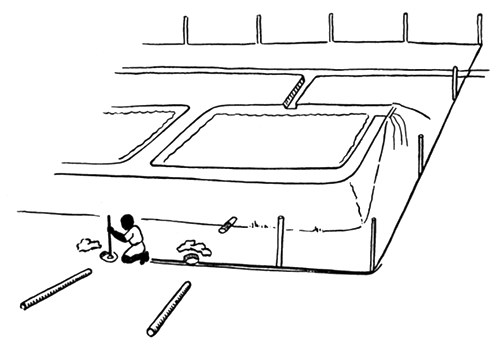
Figure 25. Fencing the pond. Above: Poles are put in around the ponds. They are buried at least 2 ft in the ground, with 4 to 5 ft above the ground. Just outside the line of the poles a trench is dug. It is about 4 to 6 in. deep. Below: Fencing wire is put between the poles at the top. The wire netting is buried in the ground at the bottom and is bent over outside at the top. The wire netting is tied to the top wire and the poles.
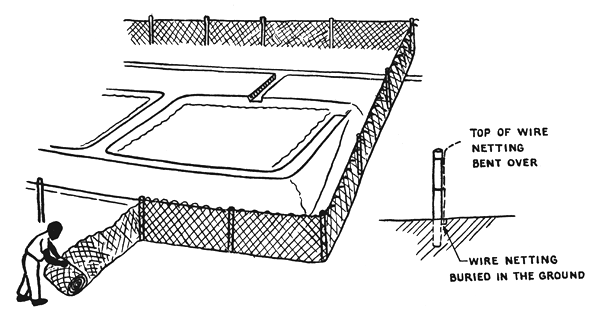
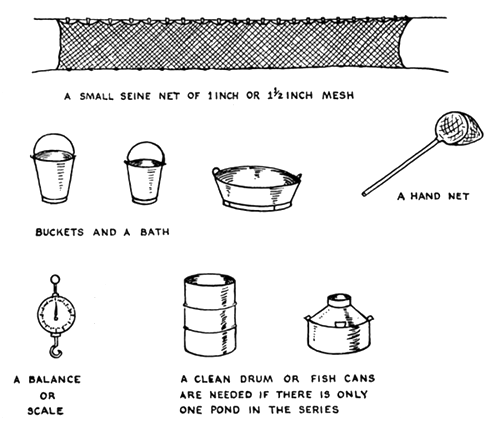
Figure 26. The most important equipment for fish pond management.
The fence
A fence is put around ponds to keep out predatory animals, such as otters, which eat a lot of fish from ponds. The best fence is one of diamond mesh wire netting or chicken netting of 2½- or 3-in. mesh and 4 to 6 ft wide. The netting is buried 4 to 6 in. in the ground and is bent outward at the top. Poles can also be used for fencing and must be at least 5½ ft long, be buried 1½ ft in the ground and put very close together (Figure 25).
Small ponds are quite quickly and easily made with hand labor using picks, hoes, shovels and wheelbarrows. For larger ponds a tractor with a disk plow and a small bucket scoop or wheeled scraper can be used economically.
Once ponds have been made certain tools and equipment are needed in management (Figure 26). For a unit of 12 ponds these are:
| 1 small seine net 1 to 1½ in.-mesh | 1 shovel |
| 2 or 3 buckets | 1 mattock or pickax |
| 1 or 2 baths | 1 hoe |
| 1 balance or scales | 1 wheelbarrow |
| 1 hand net | 1 sickle |
For a demonstration and stock pond unit the additional tools and equipment needed are:
| 6 small fish cans | 2 baths |
| 1 hand net | 1 × 56 lb platform scale |
| 1 × 1 in.-mesh seine net |
Fish culture, or intensive raising of fish, or fish farming, is a type of farming activity and is very similar in its principles to stock raising. As it is a business activity it must be run profitably. The main object is to raise the largest amount of fish by the most economical means, namely by:
Keeping the pond and installations such as outlets in a state of good repair so they will work efficiently.
Providing the best conditions in the pond for the growth of fish.
Increasing the natural food in the pond.
Making the best use of wastes and artificial foods for increasing the amount of fish production.
Good management equals successful culture and high yields of fish
The simplest and best way to manage a pond is to:
Prepare bottom soil.
Fill the pond with water.
Stock it with the right fish in the right quantity.
Feed the fish and keep the water fertilized.
Keep the pond in good order.
Crop the pond by removing the fish.
In order to have good results frequent attention is necessary to see that all is well.
The fence around the pond or pond area must at all times be kept in good repair to prevent the theft of fish by otters.
Walls if properly constructed and planted require little maintenance. After each emptying of the pond for cropping, slopes which have slipped and erosion caused by water or fish should be repaired.
Pond bottom
The soil and mud in the pond bottom is of great importance in raising good crops of fish. Excessive siltation may reduce the depth; if this occurs excess silt must be removed when the pond is drained for cropping. Ponds which have been in use for a number of years, more especially those on heavy soils, benefit from drying and exposure to the sun and air for short periods between draining and stocking. A pond used over a number of years in which the annual crop has noticeably dropped may be left for a short period of two to three weeks, (or less if it dries quickly), after one of the annual drainings for cropping. Light tillage and the working in of lime and manures restore productivity.
Water level
Ponds should never be filled level with walls. From 6 to 9 in. freeboard is necessary according to the size of the pond. The free-board is the distance between the top of the wall and the water level. Once the pond is filled it should remain at about the same level. Water must not flow in at such a rate that there is water running through the pond. Just enough is needed to keep the pond full and water flow may be adjusted so that it flows all the time, or water may be let in once a day for a period which is sufficient to keep the water level more or less constant.
Filling
The first filling should be done very carefully and slowly and each filling after draining must be done slowly, especially if the walls are dry, to avoid slumping and sliding of walls because of uneven wetting.
Draining
Draining is done at the end of the period for which the fish are grown, to remove all fish. This should be slow, to avoid damage to walls and prevent fish being left in the mud and lost. Do not leave overnight a pond in which there are still numbers of fish with too little water, as birds will come and remove many of them.
Routine management
It is a good idea to pay at least one visit a day to the ponds in the early morning. If possible another visit should be made in the late afternoon to aid full control. The following points should be checked every day:
Daily
Check fence for damage. Repair holes which will let otters in.
Check the water level and see that no water is running through the outlet. Fill or adjust furrow if necessary.
Check the outlets and inlets and all screens for clogging. Remove rubbish from screens.
Carry out necessary daily feeding after checking that food is being eaten.
Look for any evidence of theft by birds, or otters, or other animals and take necessary action.
Check furrows for correct flow and any rubbish or stones.
Make a point of noting any observations on fish — spawning, feeding, nesting, etc.
Weekly
Each week on the same day a fuller check must be made.
Carry out fully any necessary repairs that have been temporarily fixed.
Carry out manuring.
Feed with vegetation, unless this is done each day.
See that there is sufficient food available for the next week.
Check for any leaks or weak points in the walls and repair them.
See that the furrow is working properly and make any repairs.
Monthly
Each month at the beginning or end of the month:
Lime, if needed.
Remove rough vegetation such as bulrushes, etc.
Attend to any replanting of grass cover.
Each month at the end of the first week:
Fertilize.
After each draining and cropping
Inspect and repair slopes of walls.
Attend to any repairs to outlets and inlets after properly checking them. Fill cracks, replace worn brick or concrete and paint wooden parts with creosote or solignum.
Inspect the pond bottom and if there is too much silt remove some and use it on the vegetable garden.
Weed control
In ponds when herbivorous fish are used and the ponds fertilized correctly, weeds are rarely found. At low stocking rates, and in the absence of weed-eating fish, weeds may occur. The main types of weeds are:
Reeds, bulrushes and sedges rooted in the bottom and growing in shallow water.
Water lilies and pond weeds with leaves on or near the surface.
Submerged soft weeds.
Proper construction of the pond will reduce the possibility that fringing vegetation, such as bulrushes, will be a nuisance. Shallow parts should be at least 1½ ft deep.
Weeds can be removed from small ponds by cutting or pulling out, and if this is not possible when the pond is full, by digging out after the draining.
Some weeds can be controlled by chemicals, but special advice on this is necessary.
Liming
Lime, in itself, is not a fertilizer, but it is used to keep the pond bottom from getting too acid, to help release valuable fertilizing materials in the mud, and to prevent the water from becoming acid. It is useful in all cases, but it is essential where the soil is acid. The best kind of lime is agricultural lime or ground limestone.
The amount needed depends on the acidity of the soil and whether a water is soft or hard. Soft waters have little lime and salts dissolved in them; hard waters have larger quantities of lime and salts. Hard waters are best for fish culture.
More lime is needed on acid or heavy clay soils than on neutral or sandy soils. More lime is needed in soft waters than in hard waters.
It is difficult to give figures for liming as the soils and waters vary greatly. The following is a rough guide.
New ponds
Clay soils: 1,500 to 2,000 lb of lime per acre on the bottom when the pond is dry, lightly worked in if possible.
Sandy soils: 1,000 to 1,500 lb of lime per acre on the bottom.
Once a year after draining for cropping
Clay soils: 1,000 lb of lime per acre on the bottom.
Sandy soils: 500 to 1,000 lb of lime per acre on the bottom.
In small ponds where intensive feeding and manuring is being done, lime should be spread over the surface once a month at rates of 150 to 200 lb per acre, unless the inflowing water is very rich in calcium (lime).
Liming must never be done at the same time as fertilizing with phosphates.
Fertilizing the pond
The fertilizer which is added to the pond helps the growth of small plants which make up fish food.
Commercial fertilizers
The most important fertilizer is one which has a lot of phosphates. Basic slag, powdered single superphosphate, or granular double superphosphate may be used.
It is more economical in transport costs to use granular double superphosphate because only half the quantity, as compared with single superphosphate, is required.
The phosphate should be spread over the surface of the water once a month, seven days after liming, at the following rates per acre:
Basic slag and single superphosphate, 100 lb per month per acre.
Granular double superphosphate, 50 lb per month per acre.
Very weedy ponds must first have the weeds removed, as fertilizing a weedy pond is of no value to the fish.
Inorganic fertilizers are generally spread over most of the water surface. Lime can be put on the bottom of a dry or empty pond, but superphosphate should be applied when the pond contains water. Organic manures should be placed in little heaps around the pond bottom to avoid oxygen loss all over the pond.
Manures
Manures are very useful in addition to the phosphates. Pig and poultry (duck and chicken) manure may be used. Cattle manure is not as satisfactory since large quantities are needed and the response is more easily obtained with phosphates and other manures.
Either pig or poultry manure can be used (but do not use both at the recommended rates or overfertilization will result).
Pig manure - 500 to 1,500 lb per week per acre.
Poultry manure - 100 to 200 lb per week per acre.
Stocking of ponds
Ponds are stocked (i.e., live fish are put into the ponds) with such number or weight of herbivorous, plankton-eating and bottom feeding fish so as to make the best use of the naturally available foods in the pond. Likewise different kinds of artificial foods may then be used.
The usual amount of fish stock in ponds in rural areas is 200 lb per acre. Thus in a 1/10-acre pond 20 lb would be stocked, in a 1/15-acre pond 14 lb, etc. The amount of each kind of fish stocked should be about the same. For example, if two species are stocked in a 1/10-acre pond, 10 lb of each would be stocked. If three kinds, then 7 lb of each would be satisfactory.
Fish for stocking the ponds the first time after being constructed can be obtained from government fish farms. Usually later stockings are made from small fish obtained at the time of drainage, although some may also be obtained from the governmental farms.
Advice on stocking rates or species combinations and general management of ponds can also be obtained from the governmental fisheries officers.
Feeding of fish
In intensive culture the use of added foodstuffs increases the weight of fish that can be harvested.
To be of use food must be in a form that can be easily eaten by the fish. It is a waste to use fine meals or whole grains which are too large for them to eat.
In small ponds vegetation is thrown into the pond. Often the wind drives all of this into one corner. In bigger ponds it is often an advantage to keep the food from drifting everywhere by making a rectangle of bamboo or sticks which floats on the surface and is held in place by stakes driven to the bottom. In this way it is possible to see whether the fish are eating the food and whether more or less is required. Grain fodders should be soaked for some hours beforehand, so that they sink to the bottom of the pond. This food should not be strewn all over the pond but put in at definite points marked if necessary by a pole. These feeding spots should be changed from time to time. It is possible by inspection or by scooping from the bottom to see whether the food is all eaten. Floating foods like bran should be put into a feeding circle.
One of the cheapest and most useful foods is fresh green plants. T. melanopleura should therefore always be stocked in ponds as they are the fish that eat these.
Suitable types of plants are: green grass, napier fodder, banana leaves, cassava leaves, papaw leaves, sweet potato leaves, cabbage and lettuce leaves, spinach, carrot tops, kale. Large leaves can be coarsely chopped.
Grain foods that are suitable are: maize wastes and crushed cobs or crushed maize, maize bran, rice wastes, beer wastes.
Vegetation should be fed once a week.
Other foods and wastes should be fed when available, but it is better to feed small quantities frequently, rather than to give too much food only now and again. Good results are obtained by regular feeding.
Household scraps, such as pot scrapings, vegetable tops, etc., can be collected and fed daily.
In cold areas fish may stop feeding in winter when the temperature is below 15°C (59°F). Observation will show whether the food is being eaten or not.
Some foods are better than others. This is expressed by the conversion rate of the food which means the amount of food in pounds required to produce one pound of fish flesh. For example, most cereals have a conversion rate of about 5 to 1, that is 5 lb of food will produce 1 lb of fish. The conversion rate for vegetation varies, e.g., banana leaves 25, cassava leaves 13 and napier fodder 48.
Quantities that can be fed
Fresh green vegetation, 20 to 40 lb per week per pond of 1/10th-acre (200-400 lb/acre). One of the following:
Maize or rice wastes 3 lb per day (30 lb/acre) or
Dried beer waste 2 lb per day (20 lb/acre) or
Cassava roots 5 to 10 lb per day (50 to 100 lb/acre)
Note: All figures are for ponds stocked at 200 lb/acre.
Cropping (Figure 27)
In order to get the best results the simplest way, it is suggested that the small rural ponds of the size recommended, 1/10th-acre, be completely cropped once a year by draining.
If there is only one pond, enough fish must be kept alive to restock the pond.
If there is a set of 12 ponds, one can be cropped completely by draining every month of the year. This pond is then restocked a month later from the pond cropped in that month. Rotational cropping is a very good scheme since it makes available a regular supply of fish.
In the case of less than 12 but more than one pond, the last pond must be restocked with fish kept alive while the pond is being drained.
It is not necessary to take all the fish out at once if there are too many to dispose of. Cropping may be extended for a period of a month and the pond then drained completely. For example, if there are 12 ponds and one wants to supply fish every week, the following arrangement would be possible. Suppose that:
Pond No. 1 has been totally cropped and is empty.
Pond No. 2 has been under culture for a year in February.
Pond No. 3 will have been a year under culture in March.
Start cropping Pond 2 in the first week in February and restock Pond 1 with 20 lb (if 1/10th-acre). Convenient amounts of fish (in the best cases about 40 lb per week) may then be taken out of Pond 2 during February.
At the end of the month drain Pond 2 completely and restock it from Pond 3 which should then be cropped.
If there are less than 12 ponds it is a good idea to crop the ponds at the end of summer. Care must be taken in colder areas with winter stocking, however, and in the colder parts of Rhodesia it should, if possible, be avoided.
A farmer with one or two ponds can crop the ponds using a rod and line with a small hook baited with worm or porridge. The fish must stay in the pond for one complete rainy season before this kind of fishing starts. The catch in the pond will be less after a few weeks. Fishing should cease for a while and begin again a few months later. A pond in which this kind of fishing is done should still be completely cropped after one year.
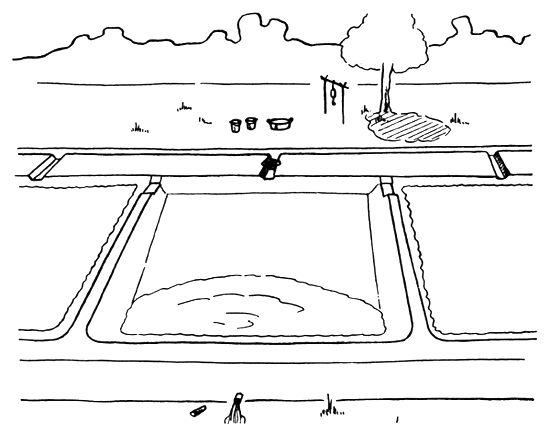
Figure 27. How to crop fish ponds. Above: Preparing a pond for netting. The pond is made ready for netting by letting the water out until there is only a pool left. Do not let ALL the water out. Below: Netting the pond. The net is pulled through the pond.
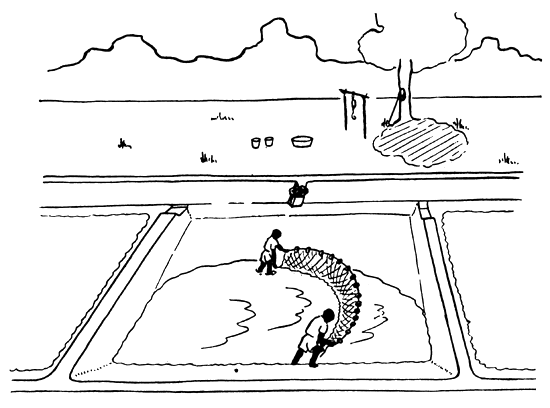
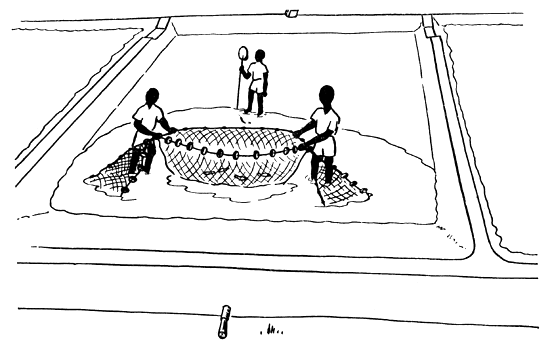
Figure 27 (CONTINUED). How to crop fish ponds. Above: Washing the fish in the pond. Fish caught in the net are washed in the pond. Below left: Weighing the fish. Fish are taken from the pond in a hand net and weighed, a few pounds at a time. Below: Fish for restocking if only one pond is used. Some fish must be put alive into drums or cans of water and later put back into the pond. The water in the drums must be agitated to keep it aerated. Not more than 20 lb of fish should be put into one drum.
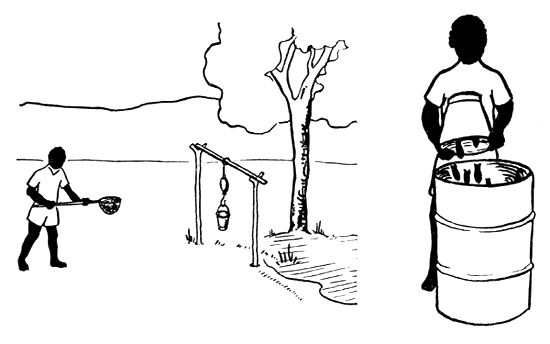
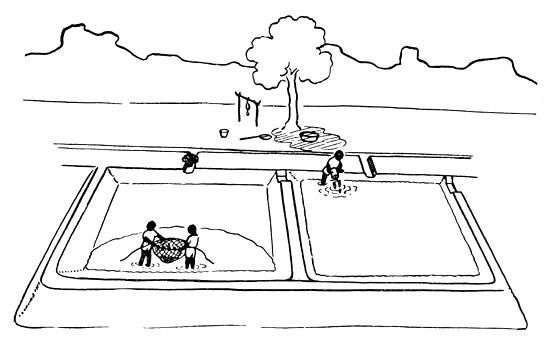
Figure 27 (CONTINUED). How to crop fish ponds. Above: Fish for restocking if more than one pond is used. If there are a number of ponds and one pond is cropped every month, then the live fish can be put straight into the pond that was cropped the previous month. Below: Removing fish. The rest of the fish that are not wanted alive are taken from the net in the pond. The fish are weighed and put in a bath in the shade. These fish are to be eaten or sold. The net is pulled through the pond again and again until only a very few fish are taken. It does not matter if a few fish are left in the pond.
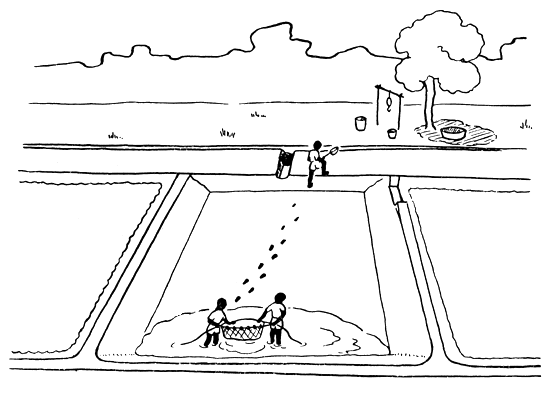
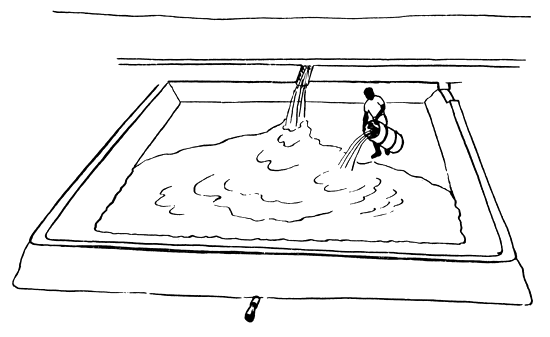
Figure 27 (CONCLUDED). How to crop fish ponds. Above: Restocking the pond. When netting has finished, the pond is inspected for holes in the walls, etc. The pond is mended if necessary and then refilled with water. If there is only one pond the live fish in the drums are put back. If there are a number of ponds then the pond will not have fish put back until the next pond is cropped. Below: Pond restocked and fish crop ready for disposal. The fish from the pond can be eaten fresh or sold or preserved.
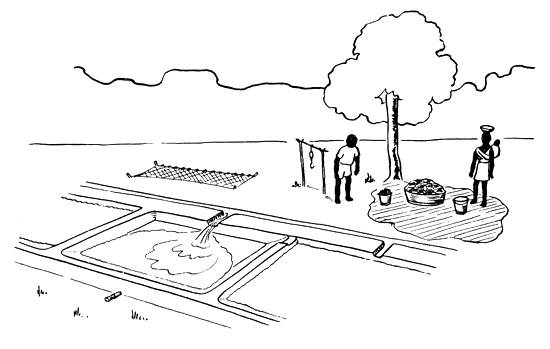
Traps may be used in small ponds. Traps are made of 1-in. chick wire mounted on a ¼-in. rod and, baited with maize porridge, may be used for cropping small daily quantities. This is often dangerous as the traps or the fish may be stolen unless the pond owner's house is near the pond. Where rod and line or trap fishing has been done, the total crop is the same as if the pond were cropped on draining. The amount taken at the draining will, of course, be less.
The total amount (in weight) of fish taken from the pond is the yield or crop. The production is the amount taken out less what was put in. In order to compare the crops from ponds of different sizes it is often the practice to work out the result per acre and if, as in the case we have used as an example, the period is a year, the crop is said to be so many pounds per acre per year.
For example, a well-managed pond of 1/10th of an acre may give on cropping one year after stocking, a weight of 200 lb of fish. The yield would then be 2,000 lb/acre/year.
The fish crop consists of fish of all sizes. If there has been good feeding, growth will have been good and there will be a fair number of fish of 5 to 6 oz and possibly more. There will also be many small fish of 1 oz or less.
If the pond has not been well looked after and the fish have not been fed, the crop will consist mainly of small stunted fish which have grown poorly.
To obtain a good crop of fish:
The pond should be properly situated and built and be adequately supplied with water.
There should be no throughflow of water.
The pond should be stocked with the right quantity and kinds of fish.
The pond area should be protected against otters and bird predators.
The correct liming and fertilizing should be carried out.
The fish must be fed.
There are a number of ways of raising fish, differing in method, aim and ease of carrying out. These are briefly described below.
Mixed method
The mixed method consists of using fish of different ages, sizes and species. This is the simplest and the only method described here in detail. Large crops of fish are obtainable, but the individual size of fish is never great.
This method is suitable for areas where water is available for the whole year and is combined with other types of farming with great advantage. Figures are given for a pond of an ideal size of 1/10th-acre.
Lime the pond bottom with 150 lb agricultural lime.
Fill the pond with water.
Stock the pond with 20 lb of fish (200 lb/acre) using about the same amount of each kind, and fish of from 3 in. long up to 6 oz or a little more in weight.
Lime the pond every month with 15 lb of agricultural lime spread over the surface (150 lb/acre).
One week after liming spread superphosphate over the surface of the pond water at a rate of 5 lb double superphosphate (50 lb/acre) or 10 lb single superphosphate or basic slag (100 lb/acre).
Feed the fish regularly (see page 49) or put in pig manure, 100 lb per week or poultry manure, 15 lb per week.
After a period of one year, crop the fish entirely by draining.
Separate age method
The aim in separate-age type of culture is to grow the fish as rapidly as possible so that they are big before they start spawning, in order to get a more uniform size and larger fish. Stocking is done with young fish of the same age, and of individual weights of less than ½ oz. The number to be stocked depends on the area of the pond, available food and growing time. This is a complex method requiring different ponds and a lot of handling.
Monosex culture
Monosex culture is not practical on a large scale and is not easy to carry out. The sexes are kept separate and usually only male fish are used. No spawning occurs so the fish do not become crowded and can grow fast.
Culture with predatory fish
This method is used to cut down the production of fry so that most of the fish produced will be big. The numbers of the predatory fish must be carefully worked out. The predatory fish used are Serranochromis robustus and the largemouth black bass (Micropterus salmoides). Though total production may be a good deal lower than when no predatory fish are present, the fish are bigger.
It is clear that the first method is the most suitable for rural fish ponds and that the other methods require more specialized techniques. They are of importance only where it is necessary to produce bigger quality fish in semi-industrial fish cultures, where the market requirements merit the extra trouble.
Fish farming combined with other branches of agriculture
The rearing of Tilapia is best combined with other types of farming. This makes for greater overall efficiency, as by-products from some of the activities are used “on site” in other branches. An ideal situation is to combine fish with a vegetable garden, perhaps under irrigation, and some form of intensive livestock raising such as pigs or poultry. Waste from the vegetable garden is used for the fish, as well as manure and food wastes from the animals; small, under-sized fish and fish offal can be fed to the animals, and excess mud from the bottom of the pond can be used for fertilizing the garden. It often happens that much of the fertility in a pond becomes locked in the soil and does not affect the growth of fish; it is wasted unless it can be used elsewhere. Figure 28 illustrates these interrelationships.
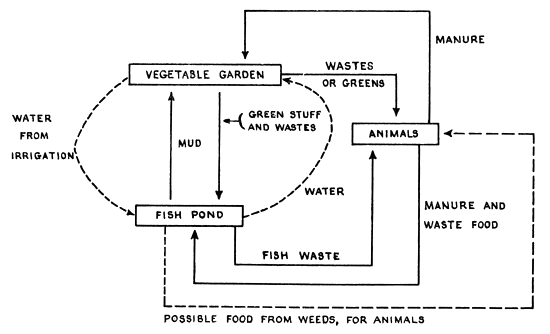
Figure 28. Combined fish, crop and livestock farming. The figure shows the relation between ponds, crops, and animals.
Ducks may be kept in conjunction with a pond, being penned nearby for fattening and the pens washed into the pond. They may be allowed on the pond, or the pond areas. In this way they get some food from the pond and help to control weeds and snails which carry bilharzia. Too many ducks should not be kept on the pond area as they destroy the walls. For larger ponds, geese may be allowed to pasture near the water. Excellent results have been obtained by using duck manure on fish ponds — yields of over 2 tons per year per acre. Peking or Muscovy are the varieties of duck most commonly used. Breeding flocks must be allowed access to the water and a suitable combination would be to allow the breeders on the pond, while keeping the fattening stock in pens. Small fish and fish offal mixed with maize is a valuable food for both ducks and poultry. Muscovy ducks are the hardiest and easiest to rear.
For a small unit of say, six 1/10-acre ponds, a breeding stock of about 40 ducks with their young will provide a suitable quantity of manure for the fish.
If hens and ducks are kept on deep litter, the litter makes excellent fertilizer for the pond, used in quantities of 500 lb per acre and either strewn on the surface or worked into the bottom.
The use of pig manure and the washings from pig sties leads to high production. As much as 500 lb per week of pig manure per acre may be used. There is a considerable amount of direct food value from this in addition to its fertilizing action. The manure from six sows and their young may be used regularly over one acre of water. One or two sows and young pigs will supply sufficient manure for a small pond.
Where there is a possibility of growing paddy rice, consideration should be given to mixed rice-fish farming. In this case the paddies are modified by having higher bunds built and a channel round the perimeter which holds 2 to 2½ ft of water when the central rice-growing area is inundated to 4 to 6 in. Fish may be stocked at any time after the rice has rooted provided the channel is full, and when the rice crop is ready for flooding will have the entire surface area at their disposal. It is advisable to use nonherbivorous fish, e.g., T. mossambica, T. macrochir or T. andersonii for rearing in paddies. The fish act as cultivators and manure the soil on which the rice is growing. When the rice crop is reaped the ponds can be filled to a full level and used entirely for fish production (Figure 29).
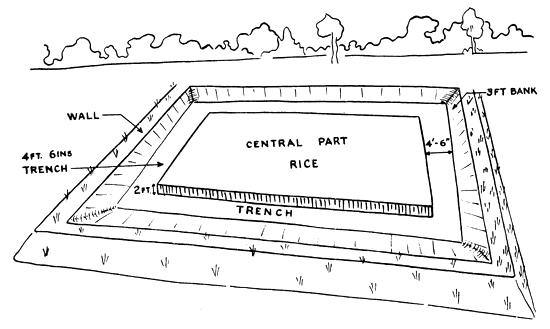
Figure 29. Fish and rice. The figure shows a pond in which fish and rice are growing.
Rearing of fish for purposes other than food
At centers established for the purpose of producing fry or young fish for stocking, special measures are often taken and separate species reared in different ponds. There are also ponds for breeding, for rearing fry, and for holding fish prior to transportation.
Forty or fifty pairs of adult Tilapia per acre are stocked in ponds of ¼- or ½-acre in larger centers. The adult fish are usually between 6 oz and 1 lb and preferably not more than two years old.
The ponds are kept well fertilized with phosphate and the young fish are removed after the breeding season. Smaller breeding ponds may be used and the young fry removed with fine nets when they are still moving in shoals and put into fry-rearing ponds. Two to five pairs of adults are used in ponds of 1/20th-acre.
Serranochromis are reared in the same way as Tilapia but precautions must be taken to prevent the adults from eating the fry once they are free from parental care. Fencing off a part of the pond with wire mesh to enable the young fish to escape is one method; or, alternatively, large ponds with vegetation growing and giving protection to the young may be used.
Haplochromis may be grown in a similar way to Tilapia.
Other fish cultures
There are other important kinds of fish culture dealing with food fish which are big industries in some parts of the world, although they have been of little importance in Africa up to the present. There are two main cultures, those of trout and of carp. Carp culture is a very old art, and began in the Far East. Carp are able to withstand lower water temperatures than Tilapia, but are also able to grow very well in warm areas. Because the culture of carp properly done requires more involved methods than Tilapia culture, and several different kinds of ponds, and since in most parts of Africa where food is short conditions are suitable for Tilapia, no consideration will be given here to carp culture.
Trout are an important culture fish in colder climates. As a basic food supply they are not of importance because they require protein food themselves, usually in the form of meat or special pellets. They are reared in small ponds, where many are crowded together without coming to harm, because fresh water passes through all the time. Their value as a high priced food is their main importance. Abundant cold, clear water is required for their culture. Breeding of the trout is generally done artificially by extracting the eggs from the female and mixing them with the milt of the male.
Other types of fish culture of some economic importance but not as food production are the breeding and culture of various kinds of ornamental fish for aquariums. This is a flourishing industry in many parts of the world.
Cichlid family
The fish of the greatest value in fish culture in central east Africa are all members of the Cichlid family and the most important belong to the genus Tilapia. For the following reasons Tilapia are highly desirable for use in intensive culture:
They are efficient converters of waste foodstuffs.
They have a short food chain.
They can be readily adapted to crowded conditions in artificial culture.
They can be easily bred.
They are generally free from parasites.
Identification
It is important to be able to identify the species of fish used for culture because some of the related species are not of value.
Each fish has two names, a generic and a specific. The generic name, for example, Tilapia, is written with a capital letter, while the specific name, e.g., melanopleura, is written with a small letter. Fish of the same species are almost identical and form a group which interbreeds freely. Fish of the same genus have certain characteristics in common in their anatomy.
The main genera (plural of genus) used in fish culture are Tilapia, Serranochromis, and Haplochromis.
One of the best ways of deciding to which of these genera a fish of the Cichlid family belongs is to examine the gill rakers, i.e., the teethlike projections on the gill arch, which may be seen by lifting up the gill cover or cutting it away.
If the gill rakers are thick and partly T-shaped or knoblike, the mouth large, set at an angle to the horizontal, spots on the anal fin, and bodies long in proportion to depth, the genus is Serranochromis (Figure 30).
If the gill rakers are fine, the mouth usually small, and there are no spots on the anal fin, the genus is Tilapia (Figure 31).
If the gill rakers are short and stout and there are orange spots on the anal fin, the genus is Haplochromis.
Tilapia
This is a widespread group. Five species are of importance (T. melanopleura, T. sparrmanii, T. andersonii, T. mossambica and T. macrochir). In various countries in central east Africa there has been and is being introduced Tilapia zillii. The Tilapia are relatively easily separated into species by counting the gill rakers and by identifying other features:
8 to 12 rakers on lower part of first gill arch:
T. melanopleura: Usually with a pink or red chest and five
or six dark vertical bars on the body. The tail fin is speckled
and darker in the upper half than in the lower. Widespread
from Upper Congo to South Africa (Figure 32).
T. sparrmanii: The color varies but there is never a pink
chest, the number of dark bars is seven to nine and the tail is
uniform. Widespread in occurrence.
14 to 20 gill rakers:
T. mossambica: The snout is often longish and the profile is concave. Does not occur in Upper Zambesi, but is widespread from Rhodesia southward and in tributaries of the middle and lower Zambesi (Figure 33).
| Figure 30. Gill rakers of Serranochromis robustus, thick, knoblike. Compare with Tilapia (Figure 31). | 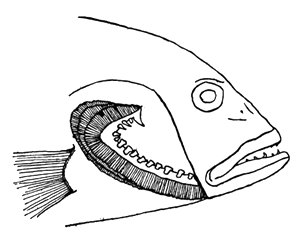 |
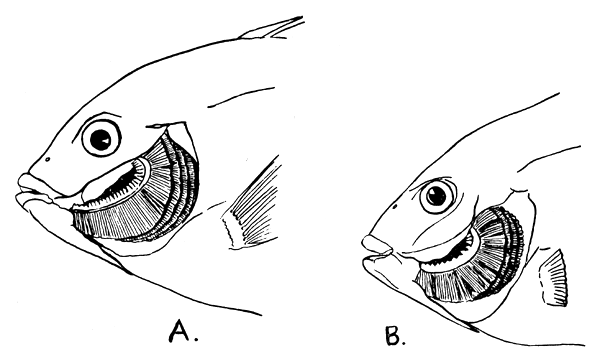
Figure 31. Gill rakers of T. macrochir and T. melanopleura. A. T. macrochir head with gill cover removed to show 23 gill rakers on lower part of arch. B. T. melanopleura head showing 10 gill rakers on lower part of arch.
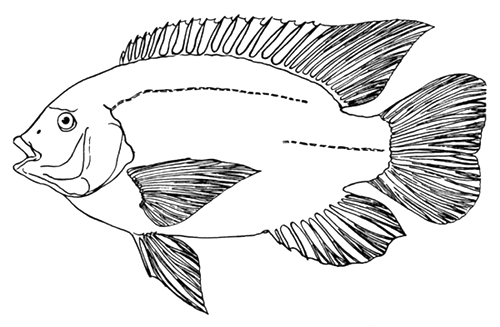
Figure 32. Tilapia melanopleura.
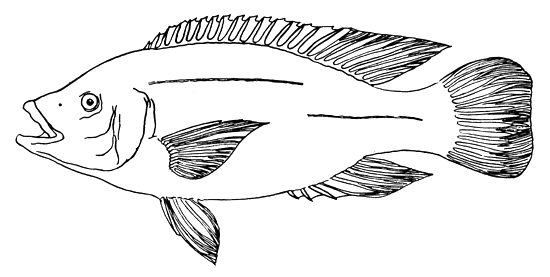
Figure 33. Tilapia mossambica.
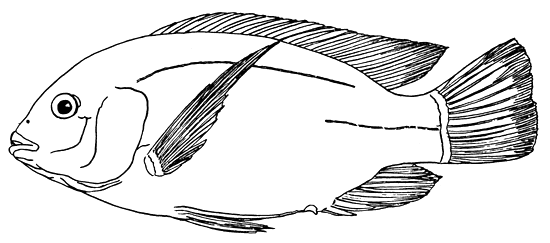
Figure 34. Tilapia macrochir.
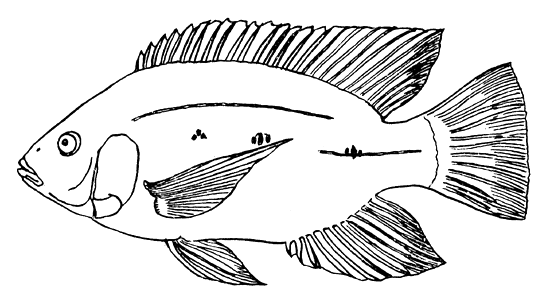
Figure 35. Tilapia andersonii.
20 to 26 gill rakers:
T. macrochir: Sides of head speckled, body greenish and
always with a rounded or convex snout. There is often a red
rim round the eye. Occurs in Congo, Upper Zambesi, Kafue
and Okavango river systems (Figure 34).
T. andersonii: Profile of head sloping, silvery in color. Often
has three black spots along the side of the body. Occurring
in the Kafue, Upper Zambesi and Okavango river systems,
generally found only in large rivers or swamps (Figure 35).
Serranochromis
There are four species which occur in the Kafue River in Zambia, in the Upper Zambesi and the Okavango, and some of these are also found in the Congo River system.
The teeth in the upper jaw are used as a guide in separating the species (Figure 36).

Figure 36. Teeth of Serranochromis. Left: More than 3 rows of teeth in upper jaw. Top S. angusticeps. Bottom: S. thumbergi. Right: 2–3 rows of teeth in upper jaw. Top S. macrocephala. Bottom: S. robustus.
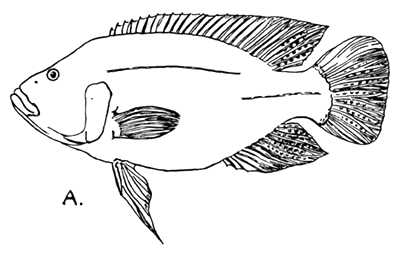 | 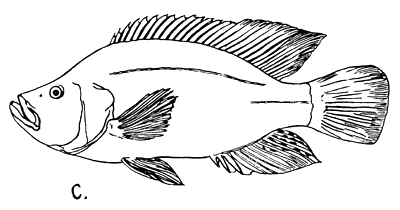 |
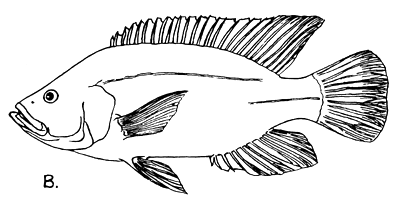 | 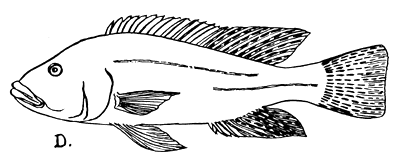 |
Figure 37. Serranochromis species. A.S. robustus. B. S. macrocephala. C. S. angusticeps. D. S. thumbergi.
2 to 3 rows of widely spaced teeth in the upper jaw.
S. robustus: Body color green above the lateral line and yellow
to white below. Profile often concave (Figure 37A).
S. macrocephala: Body dark blue to purple above the lateral line.
Profile of head usually straight or slightly concave (Figure 37B).
More than three rows of teeth close together in upper jaw.
S. angusticeps: Variable body color. Head narrow with eyes placed
close together and profile concave. Deeper bodies than most.
Mouth is able to be pushed out somewhat (protractile) (Figure
37C).
S. thumbergi: Body color light green above lateral line and
whitish below. Broad head with eyes wide apart. Profile convex.
Body slender. Caudal fin truncate (Figure 37D).
Haplochromis
Fish suitable for fish culture are included in the Haplochromis group, as well as fish which rarely grow to a size of more than a few inches. Identification of the larger growing species is difficult and reference should be made to fisheries departments.
The main features are a short snout, gill rakers usually less than 12, a large mouth with small teeth in three or four rows and orange spotted anal fins, noticeably in the two smaller species.
The most common small species are:
H. philander: rounded tail fin.
H. darlingi: square-cut tail fin and usually slender body as compared with the former.
There are five other larger species of which three are of interest in fish culture and which feed on water snails:
H. mellandi
H. carlottae
Pelmatochromis robustus
In the following descriptions vernacular names have been omitted, as they vary from area to area. The numbers following the name refer to the number of the fish mentioned in the works of Jackson (1961) and Jubb (1961), respectively.
Tilapia melanopleura (Jackson, 132; Jubb, 80: see Figure 32)
This fish is less tolerant of cold water than T. mossambica and T. sparrmanii and deaths occasionally occur in cold areas when the water temperature drops below 12°C (53°F) or 13°C (55°F). It has been satisfactorily established in ponds and conservation dams in areas where it does not generally occur in the rivers because of cold water.
Breeding
The fish start to spawn when the water reaches about 20°C (68°F). The nest is built by the male and consists of a group of five to ten holes close together, usually in a larger depression when they are built on the bottom of ponds. Each hole is 2¼ to 4 in. in diameter and is built from 6 in. to 3 ft below the surface, but usually rather less than 3 ft. The number of eggs laid at a time varies according to the size of the female — from 1,000 for small fish, and up to 5,000 to 6,000 for larger fish over 10 oz.
Females usually become mature after one summer at about seven months, but under pond conditions maturity may be reached earlier. The eggs are laid in one of the depressions and from time to time moved in the mouths of the parents to neighboring holes. Hatching takes place after about five days, depending on the water temperature. The young fish are cared for over a period of two to three weeks by the adult fish, until they are big enough to look after themselves. Egg laying occurs at approximately seven-week intervals if the temperature remains high enough. From each spawning, or egg laying, approximately half of the eggs result in free swimming fry.
Feeding
Young fish of up to 2 in. eat small crustacea and animal plankton, but this is gradually replaced by plant food as the fish grow.
When plant material is lacking, the fish will eat detritus, muck on the bottom, insects or artificial feeds of various kinds. The food habits of this fish make it a useful agent for weed control in conservation dams. In culture the fish are fed on chopped grasses, papaw and banana leaves and similar vegetable matter.
Growth
The males grow faster than the females and reach a bigger size. In big open waters where food is abundant sizes of 2½ to 3 lb and lengths of 15 to 16 in. are attained. In ponds growths of 6 oz to ½ lb per year are recorded under moderate stocking rates, or 4 to 6 oz under normal conditions.
T. sparrmanii (Jackson, 133; Jubb, 79)
This is a hardy fish which can stand up to water temperatures much lower than those tolerated by the other Tilapia and the lowest limit is recorded as 7°C (45°F). Therefore this fish has a place in fish culture in cold areas, but it rarely grows much above ¼ lb. The largest size recorded from Zambia is 10 oz. It is widely distributed and occurs naturally in many conservation dams, where it is readily caught in gill nets of 2½ to 3-in. stretched mesh. Breeding occurs at temperatures of 17°C (62°F) and when the fish are small. Like T. melanopleura, this fish is a guarder and not a mouthbreeder. A female of 7½ in. is recorded as having 3,300 eggs in the ovaries. Small fish feed on animal plankton and as they grow bigger get more food from the bottom and also eat a certain amount of vegetation. When alive the fish is clearly distinguished from T. melanopleura by its coloring, and when dead by the fact that it has a lower number of spiny and soft rays on the dorsal fin and fewer scales along the lateral line.
T. melanopleura, 29 to 32 scales in lateral line. 13 to 16 spiny rays, 10 to 14 soft rays.
T. sparrmanii, 27 to 29 scales in lateral line. 12 to 15 spiny rays, 9 to 12 soft rays.
T. mossambica (Jackson, 130; Jubb, 78: see Figure 33)
This fish is widespread and is tolerant of water temperatures of 10°C (50°F) for short periods, although for extended periods water of 12–14°C (53–57°F) may be lethal.
It is well suited to fish culture and has been introduced into many parts of the world.
Breeding
Spawning starts once the water temperature reaches 19° to 20°C (66°–68°F). The nest dug by the male is in the form of a large saucer-shaped hole on the pond bottom in 1 to 3 ft of water — generally at depths greater than those of T. melanopleura. Breeding is reported from an age of two to three months under pond conditions, but in the wild state, and more generally in ponds, does not occur until the fish is 6 to 9 months old. Fish of 4 in. lay about 100 eggs, while fish of over 7 in. produce about 1,000. The lower number of eggs is associated with a greater amount of care by the adults. The eggs, after being laid, are taken by the female into her mouth and there hatch after two to three days. The fry remain in the mouth for a further five to eight days and once they are free swimming are guarded by the female, taking refuge in her mouth to escape danger. Guarding continues for approximately three to six weeks from spawning. Spawning is reported to continue at approximately six weekly intervals as long as the water remains above 19°C (66°F). Frequency of spawning varies according to the conditions and is probably much less frequent in the natural state than in ponds.
Feeding
Young fish eat small animals in the water, small, single-celled plants and some plants and animals from the bottom. Fish of over 3 in. become feeders mainly on plant plankton, some vegetation and bottom algae. Artificial foods such as mill sweepings, bran, etc., are readily taken by the fish in ponds.
T. macrochir: (Jackson, 129; Jubb, 76: see Figure 34)
This fish is widely used in fish culture in Zambia and further north. There appear to be two different varieties distinguished by the type of nest built. The fish from the Congo basin build a starshaped nest, while those found in the Kafue and Upper Zambesi build a cone with a saucer-shaped depression on top (Figure 38). It is possible that the Kafue/Upper Zambesi fish are better adapted to cooler water and appear to start spawning earlier than the Congo variety.
Breeding
Spawning starts at temperatures of 20° to 21°C (68° to 70°F). The male builds a nest in water of 1 to 4 ft in depth and the female is a mouthbreeder. The number of eggs is greater the larger the female; fish of 8 in. or ½ lb lay 1,000 to 1,500 eggs at a time. Females mature from eight months to a year, reaching sizes of 4 to 8 in. After the eggs hatch, usually within about five days, the female retains them for a short period in her mouth and cares for them for two to three weeks. Spawning occurs every five weeks or so in warm areas during the rainy season from October to March. One female will produce some 3,000 to 4,000 eggs per year.
Feeding
Young fish are similar in feeding habits to the other Tilapia, while those over 3 in. are almost entirely plankton feeders and browsers, taking small plants (algae) growing on larger plants. The fish readily take artificial food and grow well in fertilized ponds.
Growth
Large specimens of over 5 lb occur, but the usual size in most waters is less. As a result of frequent breeding the growth of the female is very much slower than that of the male. In ponds the larger fish of 8–12 oz are usually males and the smaller fish of 6–8 oz are females. Growth of 8 oz per year for young fish is normal and a satisfactory rate of increase. Intense stocking rates give less satisfactory growth. In large open waters females reach 1 lb and males 2 lb in a year. As with all fish the growth rate in part depends on food and the extent of the warm period.
Growth
The females grow more slowly than the males. In six months fish reach 2 to 4 oz with good feeding and 6 to 8 oz in a year.
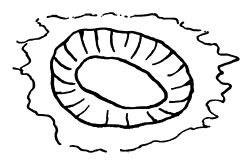 | 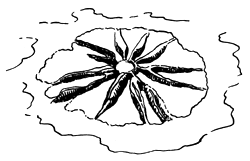 |
| T. ANDERSONII NEST | T. MACROCHIR NEST - CONGO |
 |  |
| T. MOSSAMBICA NEST | T. MACROCHIR NEST - KAFUE |
 | |
| T. MELANOPLEURA NEST | |
Figure 38. Nests of Tilapia species.
T. andersonii (Jackson, 131; Jubb, 77: see Figure 35)
This fish may at first sight be confused with T. mossambica, but its high gill raker count and longer gill rakers differentiate it, as does a closer inspection of external characteristics, e.g., the tail is less speckled. It does not naturally occur in the same waters as T. mossambica and replaces the latter in the Okavango and Kafue systems.
Breeding
The nests are saucer-shaped hollows in water of 12 in. to 1½ ft deep and are 7 in. to 2 ft in diameter, depending on the size of the male. Females mature later than the other Tilapia, the youngest recorded being 11 months and the smallest (although not necessarily the youngest) 7 in. and between 3 and 4 oz. The usual age at which females mature in ponds is between 12 and 15 months, at sizes of 6 to 8½ in. The females produce fewer eggs than the other species, usually between 300 and 700 depending on the size of the adult. Spawning starts at temperatures above 21°C (70°F) and usually only one brood per female is produced before being harvested. This is of importance in pond culture, since overpopulation is not, therefore, so likely to occur. The female carries the eggs in her mouth and cares for them for two to three weeks after hatching. The time from egg laying to the end of parental care is five to five and a half weeks.
Feeding
The fish are bottom feeders from their earliest stages and feed on algae. Artificial food of suitable size sinking to the bottom is readily taken. In many respects their feeding habits are similar to T. mossambica.
Growth
In larger waters specimens of 4 lb occur. Growth in ponds varies according to the feeding and may be 6 to 8 oz in a year.
The T. andersonii shows better growth than T. macrochir or T. melanopleura when the three species are kept in the same pond at the same rate of fish per acre.
Under normal pond conditions with good feeding the average growth of fish introduced as fry is roughly 4 to 6 oz per year.
Figures 39, 40 and 41 show the growth of three species of Tilapia in small fish ponds in Zambia and at different stocking rates.
| Figure 39. Growth of Tilapia melanopleura in ponds. | 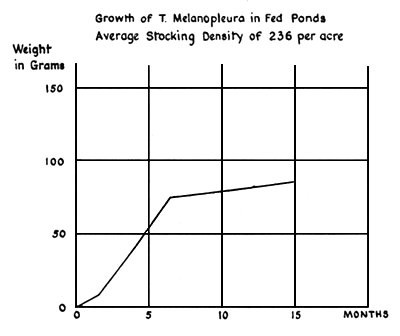 |
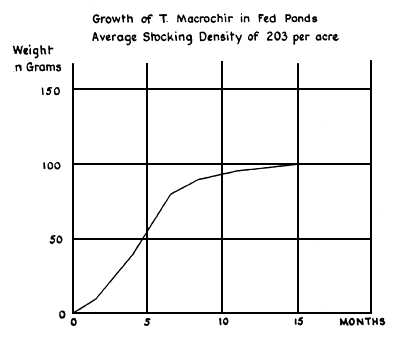 | Figure 40. Growth of Tilapia macrochir in ponds. |
| Figure 41. Growth of Tilapia andersonii in ponds. | 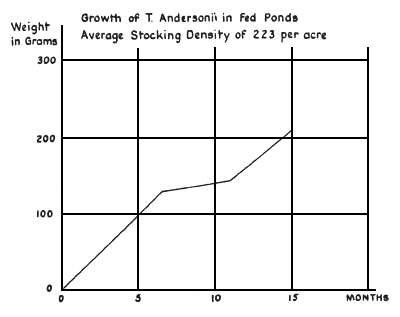 |
Serranochromis (see Figure 37, A-D)
S. robustus: (Jackson, 136; Jubb, 83)
S. macrocephala: (Jackson, 135; Jubb, 84)
S. angusticeps: (Jackson, 134; Jubb, 85)
S. thumbergi: (Jackson, 137; Jubb, 86)
Breeding
All species are mouthbreeders and the eggs are hatched in the mouth of the female. The male constructs a nest and breeding occurs from August to January in Zambia during the period of high temperatures. Each female may breed more than once during the season. Fish of 8- to 12-in. length lay between 200 and 1,000 eggs at a time. In conservation dams the smallest mature females found are about 8 in., but in ponds fish of smaller sizes may be mature.
Feeding
The young of all species feed on insects, but fish play a more important part in the diet of large fish.
As yet little is known of the rates of growth of these fish in ponds and dams. S. robustus appear to be faster growing than the other three species, with a recorded average of 10-oz increases in eight months from 8 to 18 oz.
The largest recorded weights for the species are:
| S. robustus | 7 lb | 5 oz |
| S. macrocephala | 3 lb | 2 oz |
| S. angusticeps | 5 lb | 8 oz |
| S. thumbergi | 2 lb | 10 oz |
Haplochromis (larger species only)
Breeding
All the species are mouthbreeders, the eggs and fry being carried by the female. Little information is available on the number of eggs produced but in ponds and small dams overpopulation — too many fish for the available food — may occur. H. mellandi mature at 6 in. All are snail-eating fish and H. mellandi is commonly stocked in small dams in Zambia. Ponds and small dams with H. mellandi have few or no snails, while larger dams stocked with this fish have reduced numbers. This may have some effect on the incidence of bilharzia.
| Type of feeder | Name of fish |
| Herbivorous | T. melanopleura |
| Plankton eater and browser | T. macrochir |
| Bottom feeder and algae | T. andersonii |
| Plankton and bottom feeder | T. mossambica |
| Snail eater | H. mellandi |
Suitable combinations of fish, therefore, are:
| T. melanopleura | } | T. melanopleura | } |
| T. macrochir | T. macrochir | ||
| T. andersonii | |||
| T. melanopleura | } | ||
| T. melanopleura | } | T. macrochir | |
| T. mossambica | T. mossambica | ||
| T. melanopleura | } | ||
| T. andersonii |
In addition H. mellandi is used in Zambia where it occurs in ponds in order to cut down the number of snails.
It is highly desirable to use fish only from river systems to which the pond culture is connected.